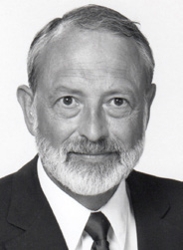

|

|
IN MEMORIAM
Robert S. Loomis
Professor of Plant Sciences, Emeritus
UC Davis
1928-2015
Robert S. “Bob” Loomis died peacefully at home in Davis, Calif. on March 27, 2015, at age 86. He was born October 11, 1928, in Ames, IA, the second son of Walter Earl and Helen Loomis. He graduated from high school early to attend Iowa State University. While at ISU, he met Lois Ann Morris in freshman chemistry class, always maintaining that she was the prettiest girl in the class. They were married in 1951 and enjoyed 58 years of marriage until Ann's passing in 2010.
He received his M.S. degree in botany at the University of Wisconsin in 1951 for work on the quantum efficiency in photosynthesis under the guidance of J.F. Stauffer and F. Daniels. After service in the U.S. Air Force engaged in atmospheric research at the Air Force Cambridge Research Center, he worked on the A.C. Moms farm near Kellogg, IA before returning to Wisconsin in 1953 where he earned his Ph.D. in botany with research on the physiology of corn borer resistance under Stauffer and S.D. Beck. That work led to the isolation of DIMBOA and demonstrations of its role in insect and disease resistance.
Loomis joined the faculty of agronomy at the University of California, Davis in 1956 for research on sugar beet physiology. His early work with sugar beet emphasized the physiology of nutrient and water stress and photosynthesis. As a Fellow at Harvard University with Professor J.G. Torrey in 1963 to 1964, he elucidated the hormonal controls over cambial activity in radish.
In 1962, he began a long and productive relationship with W.A. Williams in studies of the structure and photosynthetic activities of foliage canopies. That led eventually to cooperative studies with W.G. Duncan of the University of Kentucky on explanatory crop simulation models. In addition to the Duncan photosynthesis model, Loomis was involved with dynamic simulation models for sugar beet, potato, and alfalfa, a cellular model of N assimilation, and a host-pathogen model for powdery mildew. The modeling efforts were aimed towards studies of integrative physiology, bioclimatology, and ideotype identification.
In later years, the work of Loomis and his students turned more towards partitioning aspects of production systems. In addition to the work with sugar beet, synthesis respiration and N-use efficiency of various crops were emphasized. The research work was closely coupled with Loomis' strong interest in research training. Twenty seven students earned advanced degrees under his direction and twenty visiting scientists and postdoctoral students worked in his laboratory group.
Loomis was active in other ways within the university and the profession. Noteworthy among his many roles at Davis were service as Faculty Athletic Representative and Chair of the Intercollegiate Athletic Board, director of the Institute of Ecology, first Chair of the Ecology Graduate Group, Associate Dean for Environmental Studies, member of the Policy Committee of the University of California - University of Chile Convenio, and as a Davis Representative to the Statewide Assembly of the Academic Senate.
Professionally, Loomis participated in 1967 in the Alpha-Helix Amazon Expedition and held visiting scientist appointments with Harvard, PSIR (Palmerston North), the Agricultural University of Wageningen, and the University of Melbourne. He held the posts of Chair of the Western Section and Secretary in the American Society of Plant Physiologists and served on several committees of CSSA and ASA.
Loomis was internationally known for his broad overview of agricultural science and had many review and synthesis articles as well as service on many consultative panels including membership on the U.S. Committee for an International Geosphere-Biosphere Research.
After retiring in 1991, he continued to work as an editor for several journals and, with David Connor (University of Melbourne, Australia) and Kenneth Cassman (University of Nebraska, 2nd edition), wrote "Crop Ecology: Productivity and Management in Agricultural Systems," which compiled relevant thinking about the limits and potential productivity of agricultural systems.
During college Loomis spent two summers as a lookout fireguard in the Clearwater National Forest in Idaho, where he manned a fire lookout tower and maintained trails. This experience led to a passion for the outdoors that he shared with his family and friends on many camping and backpacking trips over the years. He was an avid sailor and longtime member of Lake Washington Sailing Club. He enjoyed many travels that included sabbaticals to Boston, New Zealand, The Netherlands and Australia as well as visits to his family, friends, colleagues and former students around the world.
Through Loomis’ accomplishments UC Davis gained international recognition for crop science innovation and excellence. He was reserved, thoughtful and considerate but would engage in lively discussions. He fostered critical thinking in crop ecology, bioenergetics and canopy architecture; those ideas and his experimental evidence led to new directions in maize breeding. He linked laboratory results to field studies and computer models to describe yield determination. As a classroom educator he engaged students in discussions, developed concepts, challenged ideas and insisted on their very best efforts to achieve understanding of technical concepts.
Loomis’ contributions were recognize in the academic community by his election as a Fellow in three national honor societies’, ASA, CSSA, and AAAS.
He is survived by daughters Susan, Sarah (Rodney Paul) and Caroline; grandsons Alex, Thomas, Robert and Matthew May.
Don Nevins
Richard Plant
Bill Rains